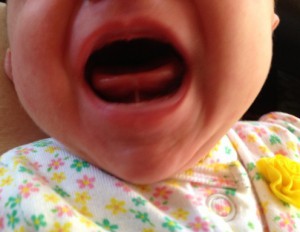My lactation consultant told me my baby is tongue tied and she needs to get her frenulum clipped so she can breastfeed. What is a frenulum? Why does my baby need this procedure?
The frenulum is a (usually) thin, fibrous band of connective tissue that connects the underside of the tongue to the floor of the mouth. The mere existence of a lingual (tongue) frenulum is not an indicator of a problem. The important thing is whether the frenulum restricts the movement of the tongue in a way that interferes with its normal functions. If it does, your baby has a condition known as tongue tie or ankyloglossia.
One of the first vital roles of the tongue for a baby is for feeding. Your baby depends on her tongue for creating a vacuum, sustaining a vacuum, moving the milk to the back of her mouth and swallowing. These things are important whether a baby is breastfeeding or bottle feeding. But when a baby is breastfeeding, the function of the tongue is more critical because incorrect tongue movement/placement equals sore nipples for mommy!
How do you know if your baby is tongue tied? Take a minute to observe your baby with this questions in mind:
- Does your baby have a hard time latching on?
- Do your nipples looked creased or flattened after breastfeeding?
- When your baby cries, does the center of his tongue look “’stuck” to the floor of his mouth with just the edges curling up?
- When your baby sucks on your finger, do you feel the lower gums either constantly or intermittently?
- Does your baby seemed stressed with a fast flow of milk?
- Do feedings take a long time? Or is baby feeding very frequently and never seems satisfied?
- Does your baby have symptoms of reflux?
 If the answer to any of these questions is yes, your baby may be tongue tied! Check with an experienced lactation consultant to be sure. She will examine the baby—paying particular attention to assessment of tongue function. She will also observe the baby feeding. After a thorough evaluation, the lactation consultant may recommend that the baby have the frenulum clipped.
If the answer to any of these questions is yes, your baby may be tongue tied! Check with an experienced lactation consultant to be sure. She will examine the baby—paying particular attention to assessment of tongue function. She will also observe the baby feeding. After a thorough evaluation, the lactation consultant may recommend that the baby have the frenulum clipped.
The clipping—called a frenotomy—is usually performed by a doctor or dentist. The doctor will assess tongue function, may observe a feeding or ask you detailed questions about your breastfeeding. You should be given instructions to stretch your baby’s tongue periodically after the procedure to ensure that it heals properly. The discomfort the baby experiences is mild and brief–most is caused by the fact that baby is not happy about being still and fingers under the tongue feel weird! Bleeding is minimal. After this very quick procedure (it literally takes about 3 seconds) most mothers and babies notice an immediate difference in breastfeeding.
When I see a baby with a tongue tie in the Seattle area, I refer to Dr. Chenelle Roberts at Docere Center for Natural Medicine for further evaluation and treatment. She does an excellent job and I’m there at every procedure to help with breastfeeding afterword. If you suspect tongue tie, please come see us!
See also, “Tongue Tie: More than ‘Just’ a Breastfeeding Problem“


Pingback: Squeaker: A Story about a Tongue Tie Release | The Second 9 Months
I have just found your blog and stopped here be accident but I will become a constant reader here. That’s for sure!
Pingback: Tongue Tie: More than “Just” a Breastfeeding Problem | The Second 9 Months